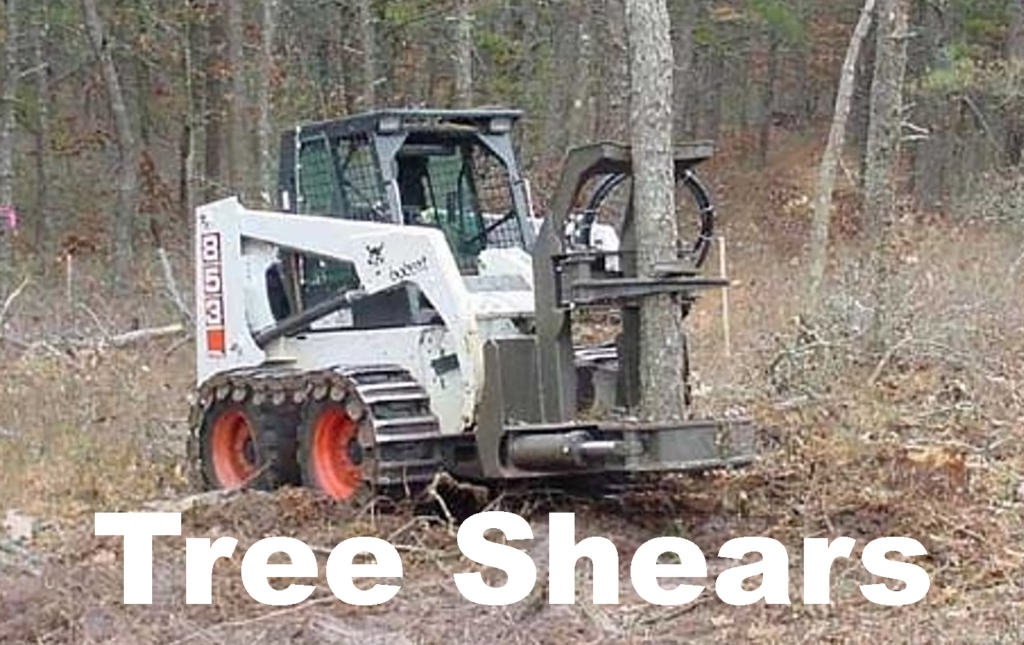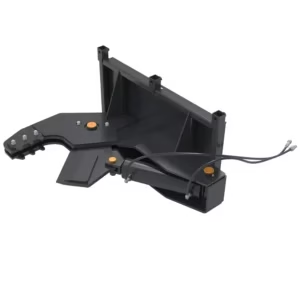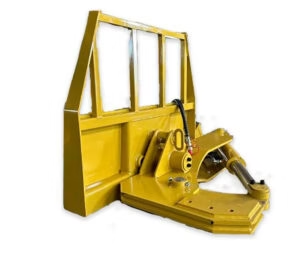
1. Overview
A tree shear attachment transforms a skid steer into a powerful forestry and land-clearing tool capable of cutting through trees, limbs, and thick brush with precision and efficiency. It uses hydraulic power to drive heavy-duty blades that shear trees at the base, making it ideal for right-of-way clearing, farm maintenance, vegetation control, and pre-commercial thinning.
2. Applications
- Land clearing and vegetation management
- Fence line and trail maintenance
- Invasive species removal
- Utility and roadside right-of-way clearing
- Tree harvesting and thinning
3. Types of Tree Shears
| Type | Description |
|---|---|
| Fixed Tree Shear | Blade shears trees in a straight cut without rotation—robust and simple |
| Rotating Tree Shear (manual or hydraulic) | Blade head rotates for angled cutting and precision placement |
| Grapple Tree Shear | Includes a grapple arm to grab and hold the tree during/after cutting |
Rotating and grapple-style shears offer better control for placement and stacking.
4. Compatibility
4.1 Mounting Interface
| Mount Type | Description |
|---|---|
| Universal Skid Steer Plate | Standard for full-size skid steers; fits most tree shear attachments |
Not typically compatible with mini skid steers due to weight and hydraulic demands.
4.2 Hydraulic Requirements
| Function | Typical Range |
|---|---|
| Main Shear Cylinder | 15–25 GPM @ 2,500–3,500 PSI |
| Rotating Head (if equipped) | Requires secondary hydraulic line or electric-over-hydraulic switch |
| Grapple Arm (if equipped) | Shares main hydraulic source or uses additional function |
Always check your loader’s auxiliary hydraulic specs before attaching.
5. Key Components
| Component | Function |
|---|---|
| Shear Blade (stationary & moving) | Hardened steel blades apply crushing/shearing force to sever trees |
| Main Hydraulic Cylinder | Provides high-pressure force to close the shear |
| Mounting Frame | Heavy-duty frame to support cutting force and resist flexing |
| Optional Rotation Head | Allows 90°–180° shear rotation for directional cuts |
| Optional Grapple Clamp | Holds tree during and after cutting for controlled felling |
| Hose Routing Guards | Protects hydraulic lines from brush and impact |
6. Operating Instructions
6.1 Pre-Operation
- Inspect all hydraulic fittings and hoses for wear or leaks.
- Mount attachment securely via quick-attach plate.
- Connect hydraulic couplers; purge air and test all functions (shear, rotate, clamp if present).
- Confirm the work zone is clear of people and obstacles.
6.2 Cutting Technique
- Approach tree square and low, positioning the base within the blades.
- Slowly engage shear—do not rush the cut, allow blade pressure to sever wood.
- If equipped with a grapple, engage it before or immediately after cut to control the fall.
- If rotating head is present, angle the blade for safer or more controlled direction of fall.
- Release and back away once tree is cut.
For trees over 10″ diameter, ensure your shear is rated to avoid blade damage or cylinder overload.
7. Safety Protocols
- Wear full PPE: helmet, eye protection, gloves, steel-toe boots, hearing protection.
- Maintain a clear radius of 50 feet during felling.
- Never stand near the shear during operation or approach from the front.
- Be aware of blade pinch zones and hose movement.
- Disconnect and depressurize hydraulics before servicing or changing attachments.
8. Maintenance Schedule
| Task | Frequency |
|---|---|
| Inspect blade edges for damage | Daily |
| Check all cylinder seals | Daily |
| Grease all pivot points | Every 10 hours |
| Torque blade bolts and pins | Weekly |
| Clean hydraulic couplers | After each use |
| Replace damaged blades | As needed |


